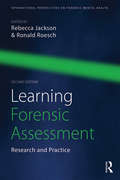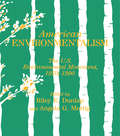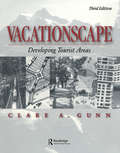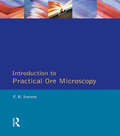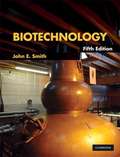- Table View
- List View
Teaching Secondary Science: Constructing Meaning and Developing Understanding
by Keith Ross Liz Lakin Janet McKechnie Jim BakerThe fourth edition of Teaching Secondary Science has been fully updated and includes a wide range of new material. This invaluable resource offers a new collection of sample lesson plans and includes two new chapters covering effective e-learning and advice on supporting learners with English as a second language. It continues as a comprehensive guide for all aspects of science teaching, with a focus on understanding pupils’ alternative frameworks of belief, the importance of developing or challenging them and the need to enable pupils to take ownership of scientific ideas. This new edition supports all aspects of teaching science in a stimulating environment, enabling pupils to understand their place in the world and look after it. Key features include: Illustrative and engaging lesson plans for use in the classroom Help for pupils to construct new scientific meanings M-level support materials Advice on teaching ‘difficult ideas’ in biology, chemistry, physics and earth sciences Education for sustainable development and understanding climate change Managing the science classroom and health and safety in the laboratory Support for talk for learning, and advice on numeracy in science New chapters on e-learning and supporting learners with English as a second language. Presenting an environmentally sustainable, global approach to science teaching, this book emphasises the need to build on or challenge children’s existing ideas so they better understand the world in which they live. Essential reading for all students and practising science teachers, this invaluable book will support those undertaking secondary science PGCE, school-based routes into teaching and those studying at Masters level.
Renewable Energy Resources
by John Twidell Tony WeirRenewable Energy Resources is a numerate and quantitative text covering the full range of renewable energy technologies and their implementation worldwide. Energy supplies from renewables (such as from biofuels, solar heat, photovoltaics, wind, hydro, wave, tidal, geothermal, and ocean-thermal) are essential components of every nation’s energy strategy, not least because of concerns for the local and global environment, for energy security and for sustainability. Thus in the years between the first and this third edition, most renewable energy technologies have grown from fledgling impact to significant importance because they make good sense, good policy and good business. This Third Edition is extensively updated in light of these developments, while maintaining the book’s emphasis on fundamentals, complemented by analysis of applications. Renewable energy helps secure national resources, mitigates pollution and climate change, and provides cost effective services. These benefits are analysed and illustrated with case studies and worked examples. The book recognises the importance of cost effectiveness and efficiency of end-use. Each chapter begins with fundamental scientific theory, and then considers applications, environmental impact and socio-economic aspects before concluding with Quick Questions for self-revision and Set Problems. The book includes Reviews of basic theory underlying renewable energy technologies, such as electrical power, fluid dynamics, heat transfer and solid-state physics. Common symbols and cross-referencing apply throughout; essential data are tabulated in appendices. An associated eResource provides supplementary material on particular topics, plus a solutions guide to Set Problems. Renewable Energy Resources supports multi-disciplinary master degrees in science and engineering, and specialist modules in first degrees. Practising scientists and engineers who have not had a comprehensive training in renewable energy will find it a useful introductory text and a reference book.
Renewable Energy Resources
by John Twidell Tony WeirRenewable Energy Resources is a numerate and quantitative text covering the full range of renewable energy technologies and their implementation worldwide. Energy supplies from renewables (such as from biofuels, solar heat, photovoltaics, wind, hydro, wave, tidal, geothermal, and ocean-thermal) are essential components of every nation’s energy strategy, not least because of concerns for the local and global environment, for energy security and for sustainability. Thus in the years between the first and this third edition, most renewable energy technologies have grown from fledgling impact to significant importance because they make good sense, good policy and good business. This Third Edition is extensively updated in light of these developments, while maintaining the book’s emphasis on fundamentals, complemented by analysis of applications. Renewable energy helps secure national resources, mitigates pollution and climate change, and provides cost effective services. These benefits are analysed and illustrated with case studies and worked examples. The book recognises the importance of cost effectiveness and efficiency of end-use. Each chapter begins with fundamental scientific theory, and then considers applications, environmental impact and socio-economic aspects before concluding with Quick Questions for self-revision and Set Problems. The book includes Reviews of basic theory underlying renewable energy technologies, such as electrical power, fluid dynamics, heat transfer and solid-state physics. Common symbols and cross-referencing apply throughout; essential data are tabulated in appendices. An associated eResource provides supplementary material on particular topics, plus a solutions guide to Set Problems. Renewable Energy Resources supports multi-disciplinary master degrees in science and engineering, and specialist modules in first degrees. Practising scientists and engineers who have not had a comprehensive training in renewable energy will find it a useful introductory text and a reference book.
Learning to Teach Design and Technology in the Secondary School: A companion to school experience
by Gwyneth Owen-JacksonLearning to Teach Design and Technology in the Secondary School is established as a core text for all those training to teach Design and Technology in the secondary school. It helps you develop subject knowledge, acquire a deeper understanding of the role, purpose and potential of Design and Technology within the secondary curriculum, and provides the practical skills needed to plan, teach and evaluate stimulating and creative lessons. This third edition has been fully updated in light of the latest curriculum, policy and theory, as well as exciting changes in the field of design and technology.? Designed to be read as a course or dipped into to for support and advice, it covers: Developing areas of subject knowledge Health and safety Planning lessons Organising and managing the classroom Teaching and learning with digital technologies Teaching wider issues through design and technology? Assessment issues Your own professional development. Bringing together insights from current educational theory and the best contemporary classroom teaching and learning, this book will prove an invaluable resource for all student and newly qualified teachers – as well as their mentors - who aspire to become effective, reflective teachers.
Learning to Teach Design and Technology in the Secondary School: A companion to school experience
by Gwyneth Owen-JacksonLearning to Teach Design and Technology in the Secondary School is established as a core text for all those training to teach Design and Technology in the secondary school. It helps you develop subject knowledge, acquire a deeper understanding of the role, purpose and potential of Design and Technology within the secondary curriculum, and provides the practical skills needed to plan, teach and evaluate stimulating and creative lessons. This third edition has been fully updated in light of the latest curriculum, policy and theory, as well as exciting changes in the field of design and technology.? Designed to be read as a course or dipped into to for support and advice, it covers: Developing areas of subject knowledge Health and safety Planning lessons Organising and managing the classroom Teaching and learning with digital technologies Teaching wider issues through design and technology? Assessment issues Your own professional development. Bringing together insights from current educational theory and the best contemporary classroom teaching and learning, this book will prove an invaluable resource for all student and newly qualified teachers – as well as their mentors - who aspire to become effective, reflective teachers.
Learning Forensic Assessment: Research and Practice (International Perspectives on Forensic Mental Health)
by Rebecca Jackson Ronald RoeschMajor developments in the field since the publication of Learning Forensic Assessment are integrated in this revised edition, including revised editions of the DSM-5, HCR-20 scale, and child custody guidelines. This textbook is designed for graduate students learning forensic assessment and psychologists coming to forensic practice later in their careers. It is organized around five broad areas: Professional and Practice Issues, Adult Forensic Assessment, Juvenile Forensic Assessment, Civil Forensic Assessment, and Communicating Your Findings. Each chapter begins with a strong teaching and learning foundation. The latter part of each chapter is assessment specific, covering available assessment measures and approaches to assessment. The authors go well beyond simple descriptions of assessment measures and provide a conceptual discussion of the evaluation process that helps the reader understand how assessment measures fit into the overall evaluation process. The evaluation component is geared toward assessing the important aspects of the construct as laid out in the early part of each chapter. Each chapter then concludes with a case example to illustrate the measures and techniques described.
Teaching Science and Technology in the Early Years (3–7)
by Dan Davies Alan Howe Christopher Collier Rebecca Digby Sarah Earle Kendra McMahonTeaching Science and Technology in the Early Years (3-7) celebrates young children’s amazing capabilities as scientists, designers and technologists. Research-based yet practical and accessible, it demonstrates how scientific, designing and making activities are natural to young children, and have the potential for contributing to all aspects of their learning. By identifying the scientific and design-related concepts, skills and activities being developed, the book enables the reader to make more focused diagnostic observations of young children and plan for how they can help move them forward in their learning. This second edition has been thoroughly updated and features: Six new chapters providing practical advice and examples for enhancing scientific and technological learning through thematic approaches a new chapter focusing on the outdoor learning environment and how this can support science and technology new case studies of successful early years practice, alongside examples of practical planning for learning, and advice on documenting children’s learning stories, guidance on the role of talk, narrative, documentation and planning in relation to early years science and technology Based on the latest research and the first hand experience, this practical and accessible book is essential reading for early years and primary students on undergraduate and Masters level courses. ? ? ?
Teaching Science and Technology in the Early Years (3–7)
by Dan Davies Alan Howe Christopher Collier Rebecca Digby Sarah Earle Kendra McMahonTeaching Science and Technology in the Early Years (3-7) celebrates young children’s amazing capabilities as scientists, designers and technologists. Research-based yet practical and accessible, it demonstrates how scientific, designing and making activities are natural to young children, and have the potential for contributing to all aspects of their learning. By identifying the scientific and design-related concepts, skills and activities being developed, the book enables the reader to make more focused diagnostic observations of young children and plan for how they can help move them forward in their learning. This second edition has been thoroughly updated and features: Six new chapters providing practical advice and examples for enhancing scientific and technological learning through thematic approaches a new chapter focusing on the outdoor learning environment and how this can support science and technology new case studies of successful early years practice, alongside examples of practical planning for learning, and advice on documenting children’s learning stories, guidance on the role of talk, narrative, documentation and planning in relation to early years science and technology Based on the latest research and the first hand experience, this practical and accessible book is essential reading for early years and primary students on undergraduate and Masters level courses. ? ? ?
Developmental Neuropsychology: A Clinical Approach
by Vicki Anderson Elisabeth Northam Jacquie WrennallThis book addresses key issues in child neuropsychology but differs from other books in the field in its emphasis on clinical practice rather than research issues. Although research findings are presented, they are described with emphasis on what is relevant for assessment, treatment and management of pediatric conditions. The authors have chosen to focus on a number of areas. First, the text examines the natural history of childhood CNS insult, highlighting studies where children have been followed over time to determine the impact of injury on ongoing development. Second, processes of normal and abnormal cerebral and cognitive development are outlined and the concepts of brain plasticity and the impact of early CNS insult discussed. Finally, using a number of common childhood CNS disorders as examples, the authors develop a model which describes the complex interaction among biological, psychosocial and cognitive factors in the brain injured child.The text will be of use on advanced undergraduate courses in developmental neuropsychology, postgraduate clinical training programmes, and for professionals working with children in clinical psychology, clinical neuropsychology, and in educational and rehabilitation contexts.
Developmental Neuropsychology: A Clinical Approach
by Vicki Anderson Elisabeth Northam Jacquie WrennallThis book addresses key issues in child neuropsychology but differs from other books in the field in its emphasis on clinical practice rather than research issues. Although research findings are presented, they are described with emphasis on what is relevant for assessment, treatment and management of pediatric conditions. The authors have chosen to focus on a number of areas. First, the text examines the natural history of childhood CNS insult, highlighting studies where children have been followed over time to determine the impact of injury on ongoing development. Second, processes of normal and abnormal cerebral and cognitive development are outlined and the concepts of brain plasticity and the impact of early CNS insult discussed. Finally, using a number of common childhood CNS disorders as examples, the authors develop a model which describes the complex interaction among biological, psychosocial and cognitive factors in the brain injured child.The text will be of use on advanced undergraduate courses in developmental neuropsychology, postgraduate clinical training programmes, and for professionals working with children in clinical psychology, clinical neuropsychology, and in educational and rehabilitation contexts.
Environmental Sociology
by John HanniganThe third edition of John Hannigan’s classic undergraduate text has been fully updated and revised to highlight contemporary trends and controversies within global environmental sociology. Environmental Sociology offers a distinctive, balanced treatment of environmental issues, reconciling Hannigan’s much-cited model of the social construction of environmental problems and controversies with an environmental justice perspective that stresses inequality and toxic threats to local communities.
Environmental Sociology
by John HanniganThe third edition of John Hannigan’s classic undergraduate text has been fully updated and revised to highlight contemporary trends and controversies within global environmental sociology. Environmental Sociology offers a distinctive, balanced treatment of environmental issues, reconciling Hannigan’s much-cited model of the social construction of environmental problems and controversies with an environmental justice perspective that stresses inequality and toxic threats to local communities.
American Environmentalism: The US Environmental Movement, 1970-1990
by Riley E. Dunlap Angela G. MertigFirst published in 1992. Routledge is an imprint of Taylor & Francis, an informa company.
American Environmentalism: The US Environmental Movement, 1970-1990
by Riley E. Dunlap Angela G. MertigFirst published in 1992. Routledge is an imprint of Taylor & Francis, an informa company.
Teaching Science
by Jenny Frost Richard B. IngleFirst published in 1995. Routledge is an imprint of Taylor & Francis, an informa company.
Teaching Science
by Jenny Frost Richard B. IngleFirst published in 1995. Routledge is an imprint of Taylor & Francis, an informa company.
Emergent Science: Teaching science from birth to 8
by Jane JohnstonEmergent Science is essential reading for anyone involved in supporting scientific learning and development with young children aged between birth and 8. Drawing on theory, the book helps to develop the essential skills needed to understand and support science in this age range. The book is organised into three parts: development, contexts and pedagogy, exploring the underpinning theory alongside practical ideas to help trainees, teachers and childcare practitioners to create high-quality science experiences for the children they teach. The text includes guidance on developing professional, study and research skills to graduate and postgraduate level, as well as all the information needed to develop scientific skills, attitudes, understanding and language through concrete, social experiences for young children. Features include: Reflective tasks-at three levels of professional development;- early career/student, developing career/teacher and later career/leader. Case studies that exemplify good practice and practical ideas. Tools for learning - explain how science professionals can develop their professional, study skills and research skills to Masters level
Emergent Science: Teaching science from birth to 8
by Jane JohnstonEmergent Science is essential reading for anyone involved in supporting scientific learning and development with young children aged between birth and 8. Drawing on theory, the book helps to develop the essential skills needed to understand and support science in this age range. The book is organised into three parts: development, contexts and pedagogy, exploring the underpinning theory alongside practical ideas to help trainees, teachers and childcare practitioners to create high-quality science experiences for the children they teach. The text includes guidance on developing professional, study and research skills to graduate and postgraduate level, as well as all the information needed to develop scientific skills, attitudes, understanding and language through concrete, social experiences for young children. Features include: Reflective tasks-at three levels of professional development;- early career/student, developing career/teacher and later career/leader. Case studies that exemplify good practice and practical ideas. Tools for learning - explain how science professionals can develop their professional, study skills and research skills to Masters level
Vacationscape: Developing Tourist Areas
by Clare A. GunnThe third edition of this classic volume integrates the idea of balancing tourism with protection of the resources upon which it depends. The text stresses the role of the community, identifies potential pitfalls, and raises issues of developmental ethics. It includes topics such as environmental impact, sustainability, and ecotourism. Special emphasis is given to the growing need for business to implement environmental protection and ecological integrity as an essential part of economic development. The book is filled with many sketches, functional diagrams, and photographs.
Vacationscape: Developing Tourist Areas
by Clare A. GunnThe third edition of this classic volume integrates the idea of balancing tourism with protection of the resources upon which it depends. The text stresses the role of the community, identifies potential pitfalls, and raises issues of developmental ethics. It includes topics such as environmental impact, sustainability, and ecotourism. Special emphasis is given to the growing need for business to implement environmental protection and ecological integrity as an essential part of economic development. The book is filled with many sketches, functional diagrams, and photographs.
Relativity Matters: From Einstein's Emc2 To Laser Particle Acceleration And Quark-gluon Plasma
by Johann RafelskiRafelski presents Special Relativity in a language deemed accessible to students without any topical preparation - avoiding the burden of geometry, tensor calculus, and space-time symmetries - and yet advancing in highly contemporary context all the way to research frontiers. Special Relativity is presented such that nothing remains a paradox or just apparent, but rather is explained. A text of similar character, content, and scope, has not been available before. This textbook describes Special Relativity when rigid material bodies are introduced describing the reality of body contraction; it shows the relevance of acceleration and the necessary evolution of the theoretical framework when acceleration is critical. This book also presents the evolving views of Einstein about the aether. In addition to a careful and elementary introduction to relativity complete with exercises, worked examples and many discussions, this volume connects to current research topics so that readers can explore Special Relativity from the foundation to the frontier.
Introduction to Practical Ore Microscopy
by P. R. InesonFirst published in 1989. Routledge is an imprint of Taylor & Francis, an informa company.
Introduction to Practical Ore Microscopy
by P. R. InesonFirst published in 1989. Routledge is an imprint of Taylor & Francis, an informa company.
Gene Cloning And Manipulation (PDF)
by Christopher HoweUpdated to reflect advances in the field, this introduction provides a broad, but concise, coverage of recombinant DNA techniques. Written for advanced undergraduates, graduates and scientists who want to use this technology, emphasis is placed on the concepts underlying particular types of cloning vectors to aid understanding and to enable readers to devise suitable strategies for novel experimental situations. An introduction to the basic biochemical principles is presented first. Then PCR and cloning using E. coli hosts and plasmid, phage and hybrid vectors are described, followed by the generation and screening of libraries and how to modify, inactivate or express cloned sequences. Finally genetic manipulation in a range of other organisms is discussed, including other bacteria, fungi, algae and plants, insects and mammals. A series of 'real-life' biological problems are also presented to enable readers to assess their understanding of the material and to prepare for exams.
Biotechnology (PDF)
by John E. SmithBiotechnology is the major technology of the 21st century, yet few people realise how much it impacts on many aspects of human society. The defining aim of this new fifth edition is to re-establish the correct understanding of the term biotechnology. Using the straightforward style that made the previous editions of his textbook so popular, John Smith once again helps students with the deciphering and use of biological knowledge. He explains the historical developments in biotechnology and the range of activities from brewing beer, the treatment of sewage and other wastes, and the creation of biofuels. He also discusses the innovations in molecular biology, genomics and proteomics, systems biology and their impact on new biotechnology. In this edition John Smith also re-examines the ethics and morality of aspects of biotechnology and puts new emphasis on stem cells and regenerative medicine and micro RNA.



